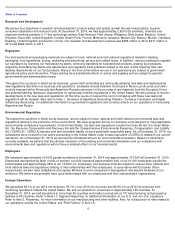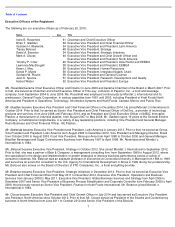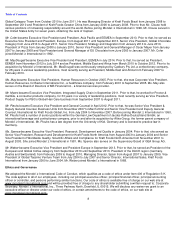Mondelez 2014 Annual Report Download - page 19
Download and view the complete annual report
Please find page 19 of the 2014 Mondelez annual report below. You can navigate through the pages in the report by either clicking on the pages listed below, or by using the keyword search tool below to find specific information within the annual report.
Table of Contents
Volatility in the equity markets, interest rates or other factors could substantially increase our pension costs.
We sponsor a number of defined benefit pension plans for our employees throughout the world. At the end of 2014, the projected
benefit obligation of our defined benefit pension plans was $12.5 billion and plan assets were $9.6 billion. The difference between
plan obligations and assets, or the funded status of the plans, significantly affects the net periodic benefit costs of our pension plans
and the ongoing funding requirements of those plans. Our major defined benefit pension plans are funded with trust assets invested
in a globally diversified portfolio of investments, including equities and corporate debt. Among other factors, changes in interest
rates, mortality rates, early retirement rates, investment returns, minimum funding requirements in the jurisdictions in which the
plans operate, the viability of other employers in the multiemployer pension plans in which we participate and the market value of
plan assets can affect the level of plan funding, cause volatility in the net periodic pension cost and increase our future funding
requirements. Legislative and other governmental regulatory actions may also increase funding requirements for our pension plans’
benefits obligation.
Volatility in the global capital markets may increase the risk that we are required to make additional cash contributions to the
pension plans and recognize further increases in our net pension cost. A portion of our pension trust assets is invested in European
sovereign debt and subject to heightened risk that it could lose value as a result of political and financial turmoil in Europe.
Due to our participation in multi-employer pension plans, we may have exposure under those plans that extends beyond what our
obligation would be with respect to our employees. Our contributions to a multi-employer plan may increase beyond our bargaining
obligations depending on the financial condition of the multi-employer plan. We may be required to participate in funding the
unfunded obligations of the plan allocable to a withdrawing employer, and our costs might increase as a result. Further, if we have a
partial or complete withdrawal from a multi-employer pension plan, we may be required to pay an amount to the plan based on our
allocable share of the underfunded status of the plan. This liability will generally increase if other employers cease participating in
the plan whether or not due to bankruptcy. (See Note 10, Benefit Plans , to the consolidated financial statements for more
information on our multiemployer pension plans.)
A significant increase in our pension benefit obligations or funding requirements could have a negative impact on our ability to
invest in the business and adversely affect our financial condition and results of operations.
Our intellectual property rights are valuable, and our failure to protect them could reduce the value of our products and
brands.
We consider our intellectual property rights, particularly and most notably our trademarks, but also our patents, trade secrets,
copyrights and licensing agreements, to be a significant and valuable part of our business. We attempt to protect our intellectual
property rights by taking advantage of a combination of patent, trademark, copyright and trade secret laws in various countries, as
well as licensing agreements, third party nondisclosure and assignment agreements and policing of third party misuses of our
intellectual property. Our failure to obtain or adequately protect our intellectual property rights, or any change in law or other
changes that serve to lessen or remove the current legal protections of our intellectual property, may diminish our competitiveness
and could materially harm our business.
We may be unaware of third party claims of intellectual property infringement relating to our technology, brands or products. Any
litigation regarding patents or other intellectual property could be costly and time-consuming and could divert management’s and
other key personnel’s attention from our business operations. Third party claims of intellectual property infringement might require
us to pay monetary damages or enter into costly license agreements. We also may be subject to injunctions against development
and sale of certain of our products. Any of these occurrences could materially and adversely affect our reputation, product sales,
financial condition and results of operations.
Item 1B. Un resolved Staff Comments.
None.
16
























